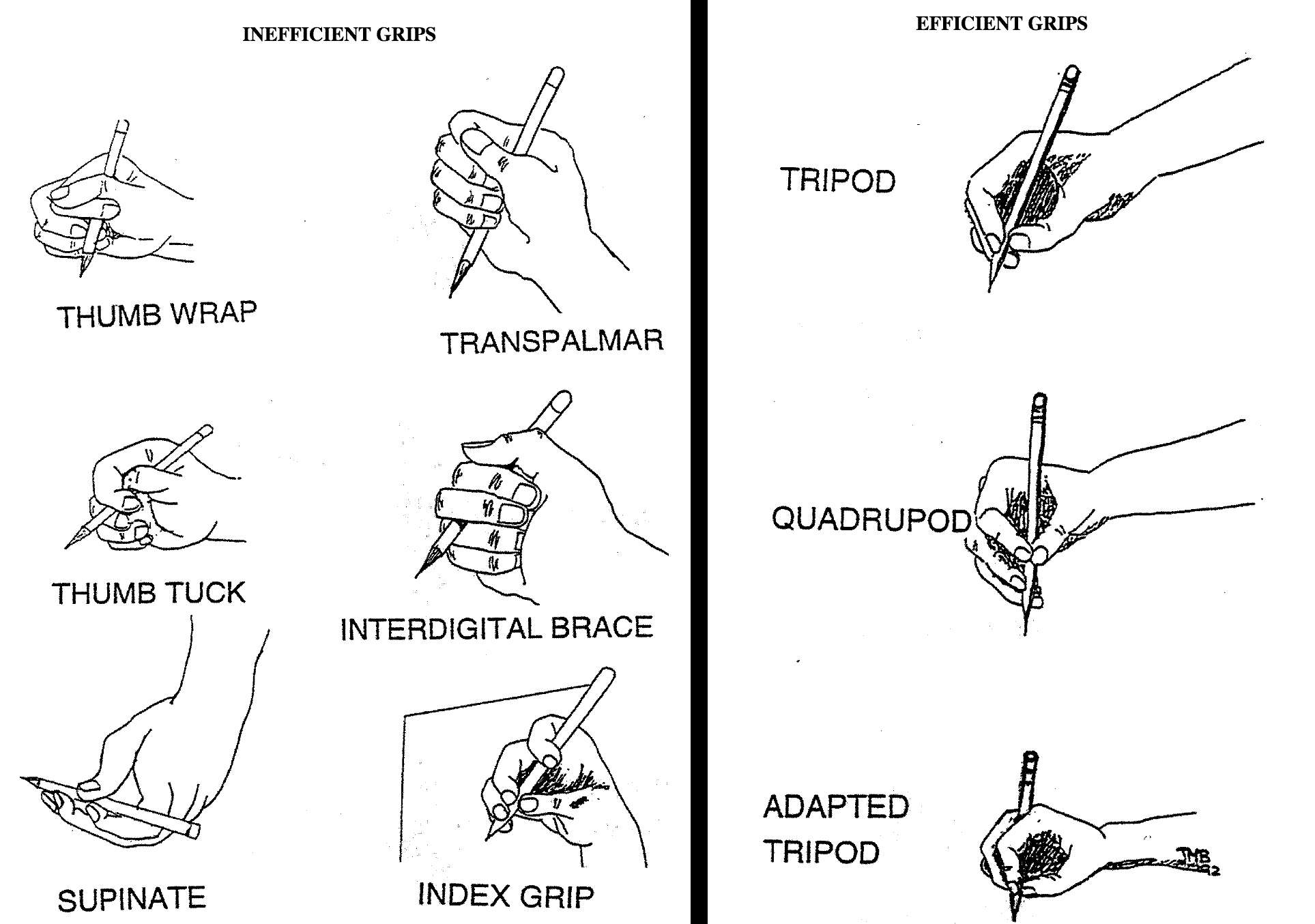
Efficient and Inefficient Handwriting Grips
July 25, 2019
An adducted grip (which diminishes the proprioceptive input from the lumbricales from the skilled digits) does not allow the luxury of the unconscious regulation of the gripping pressure on the shaft of the pencil or the downward pressure of the pencil point against the writing surface. This is the reason many students frequently need to stop, release their grip on the pencil and shake the pain out of the fingers. He should be made aware that power grips might result in painful joint dysfunctions later in life due to the stress they cause to the support structures of the joints. The following sequence can make the transition to the functional grip less stressful and more successful. 1.The instructor demonstrates how to position a pencil between index and long finger to make large random patterns on the paper using only shoulder and elbow movements. 2. The child imitates the instructor by positioning the between the same two digits to make large free flowing movements (no finger movements, letter or number symbols are allowed). 3. After the child adjusts to the feel of the pencil in the index/middle finger web space, she should be encouraged to draw anything she pleases.
Source: Benbow, Mary. Neurokinesthetic approach to hand function and handwriting. Clinician's view, 2008.
Source URL: https://www.clinicians-view.com/University/PDF/HF01/HF01TextPreview.pdf
ID: efficient-and-inefficient-handwriting-grips
Categories:
Tags: Boerhaave | COGWEB | Chinese | LSTM | Leiden | PGM | RNN | Ruysch | actors | aesthesis | agency | algorithm | analysis | anatomical | anatomy | androgynous | architecture | archive | artificialia | axis | black-box | body | botanical | brain | categories | categorization | channel | character recognition | chinese | classification | clustering | cnn | codes | cognition | collecting | collection | collections | colonialism | commodification | concept | conceptual-clustering | convolutional neural network | cost | counting | cut | cuts | cutting | datasets | demonstration | diagram | dimensionality | disgust | dissection | distance | domestication | elegance | epistemology | error | euclidean | evaluation | eye | figures | finger | forecasting | forensics | frame | freakish | geometry | gesture | gestures | gradient descent | graph | graphs | grouping | hacking | hand | hand writing | hands | hands-on | handwriting | hardware | history | human | human body | imagination | imperfect | inscription | instruments | joint | kmeans | knowledge | labeling | landmark | learning | location | machine learning | machines | materiality | meaning | measurement | memory | mnist | model | models | monsters | muscles | mystical | mythological | naturalia | nerves | nervous system | network | networks | neural networks | neural-anatomy | neuron | nonlinearity | observation | offline | online | ontologies | ontology | ontology-building | optimization | orientation | orthogonality | parallel | pca | perception | perceptron | perfection | performance | planes | poetic | position | prediction | preparation | preparations | projection | proportion | proportions | psychology | python | races | representation | representations | rhetoric | rnn | segments | selection | sensory experience | sensory perception | similarity | skeleton | skin | skull | skulls | space | sparseness | spectacle | spectators | speech | standard | statistic-ontology | statistical | statistical-ontology | svm | symbols | tacit | taxonomy | theatre | time-series | timeseries | tools | topological | training | treatise | trial | truth | type | typography | unsupervised | vision | visualization | wellcome | word2vec | writing | zodiac |